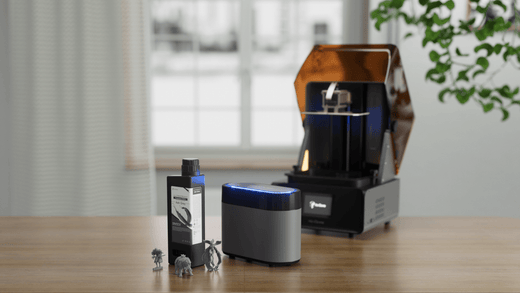What Are the Common Challenges for 3D Printed Miniatures?
3D printing miniatures is one of the most popular resin 3D printing activities, as you can create your favorite characters in unique poses and designs. However, the process of going from a 3D STL file to a printable sliced model can be quite challenging when dealing with the supports.
Miniature models, especially fantasy miniatures, often feature intricate surface details, which require numerous supports to maintain 3D printing stability, prevent deformation, and ensure great surface quality. However, improper support strategies can also lead to issues, including:

Excessive support contact points can hinder sanding and polishing efficiency and quality. Sanding these points may inadvertently remove fine details, negatively impacting surface quality. Some contact point shapes may leave pits on the surface when removing supports.

For some 3D printed miniatures, the support structures may be stronger than the thinnest parts of the model. Removing these supports may cause intricate parts to break.
To tackle support-related issues, users of light-curing 3D printers invest a lot of time and effort in optimizing supports. However, manual optimization has its limits, making it hard to achieve major improvements in printing high-quality finished products.
The Solution: An Enhancement Module for 3D Printed Miniatures
The HeyGears UltraCraft Pulsing Releasing (PRM) Module is designed for 3D printing to reduce peeling force. It pumps air into a special resin tank, for either the UltraCraft Reflex or UltraCraft Reflex RS, to create an oscillating movement of the release film which helps to detach the cured layer.

This can reduce the peeling force by approximately 50% for each layer during printing. Lower peeling force means better printability, allowing you to print with fewer supports and smaller support contact points, making post-processing surfaces and finishing your model more efficient.

The 3 Key Benefits of 3D Printing Miniatures with the PRM
When 3D printing miniatures, we recommend using our UltraCraft Reflex RS printer with PAP10 High-Precision Application Resin. Utilizing the Pulsing Releasing Module Kit alongside PAP10 can significantly enhance model surface quality by reducing the need for supports.
To demonstrate the effectiveness of the combination of the Pulsing Release Module Kit and PAP10 resin, we printed miniatures of varying heights, ranging from 2.5 cm to 15 cm, by adjusting support critical angles and support contact point diameters. The results were impressive!
1. 49%~77% Fewer Supports
The Pulsing Release Module allows models to be printed with a lower support critical angle, reducing the number of supports and contact points. This helps preserve surface details and minimizes sanding time.

2. 42%~71% Less Resin Used
The reduced volume of supports means greater resin cost savings in bulk production of 3D printed miniatures.

3. 74%~88% Smaller Overall Contact Points Area
In addition to lowering the support critical angle to 15°/20°, we also reduced the contact point diameter to 0.2 mm. All the test 3D models are printed flawlessly.

A smaller contact point diameter facilitates easier support removal and reduces damage to model details during sanding.

Currently, our BPS software allows for modifications to support contact point diameter parameters. If you wish to adjust the support contact point diameter, please refer to the following standards: When the contact point diameter is X mm, the contact point embedded depth should be 0.6X mm, and the connection tip diameter should be 0.7X mm.

We compiled experimental data from models of various sizes, comparing the effects of 15° and 40° critical angles on the supports. The usage of the Pulsing Releasing Module has resulted in significant improvements for the support structures.

Overall, the innovative technology of the Pulsing Releasing Module introduces new possibilities in the realm of 3D printing, addressing the limitations of traditional support formation and enabling the production of finer, higher-quality printed products. The HeyGears UltraCraft Pulsing Releasing Module, combined with PAP10 High-Precision Application Resin, offers an efficient and high-quality solution for 3D printing miniatures. This combination not only enables successful prints with fewer supports and smaller support contact points but also provides exceptional surface quality, intricacy, and durability, meeting the high standards demanded by tabletop gaming enthusiasts.
Looking to enhance your tabletop miniatures 3D printing efficiency? We recommend the following:
- UltraCraft Reflex RS 3D Printer: Learn more here
- UltraCraft Reflex RS Pulsing Release Module Kit: Learn more here This kit includes the Pulsing Release Module and the RS Heated & Pulsing Release Resin Tank, featuring automatic heating functions.
- UltraPrint-Production PAP10 Precise Detail Resin: Explore the resin here



Share:
Guide to HeyGears PVC-Like Resin PAF10